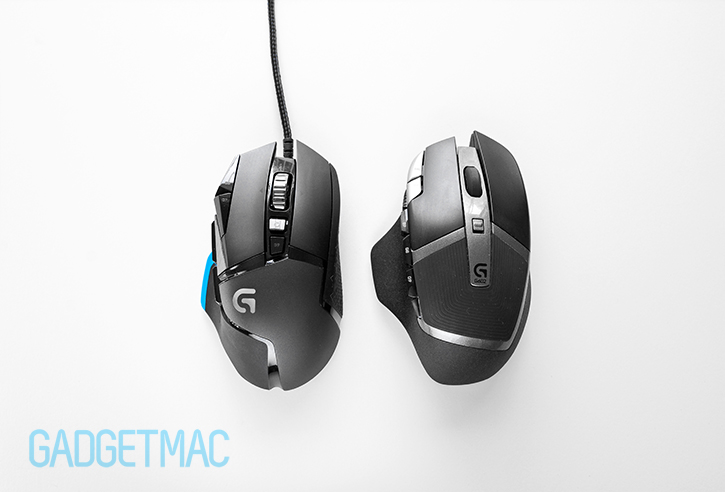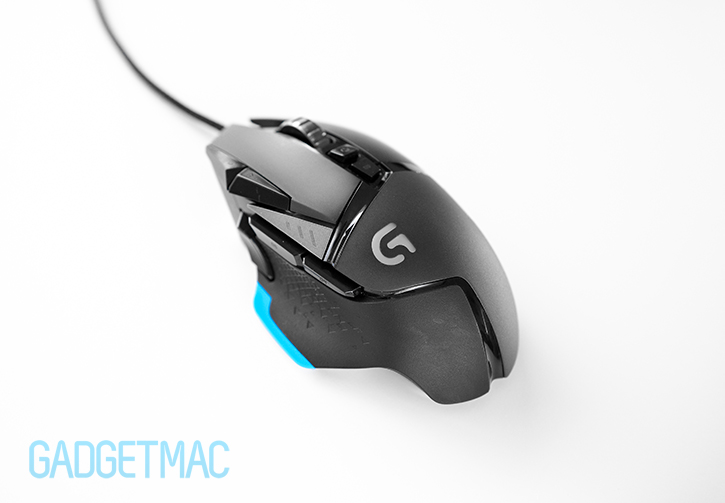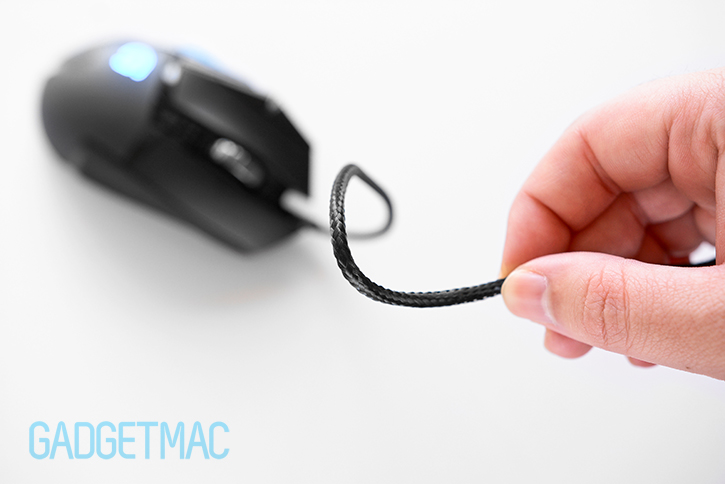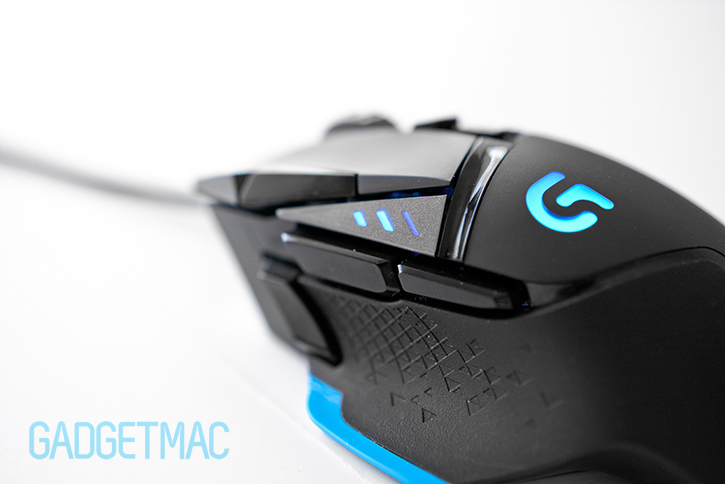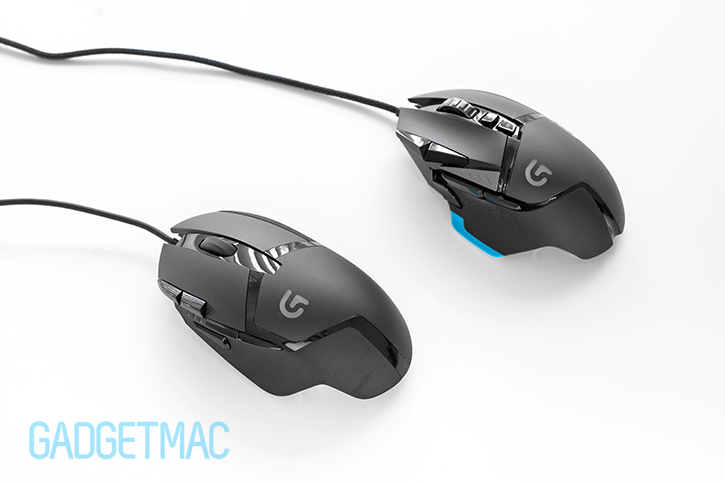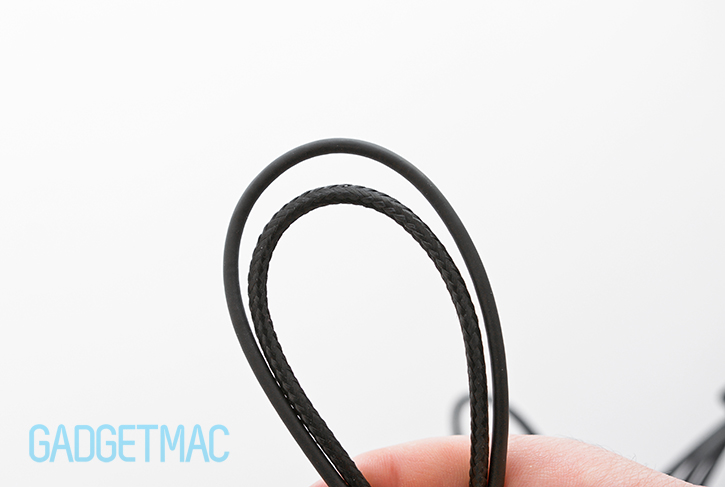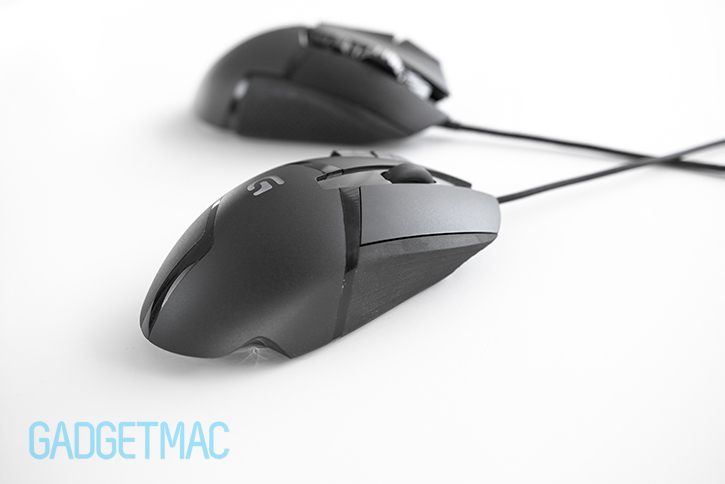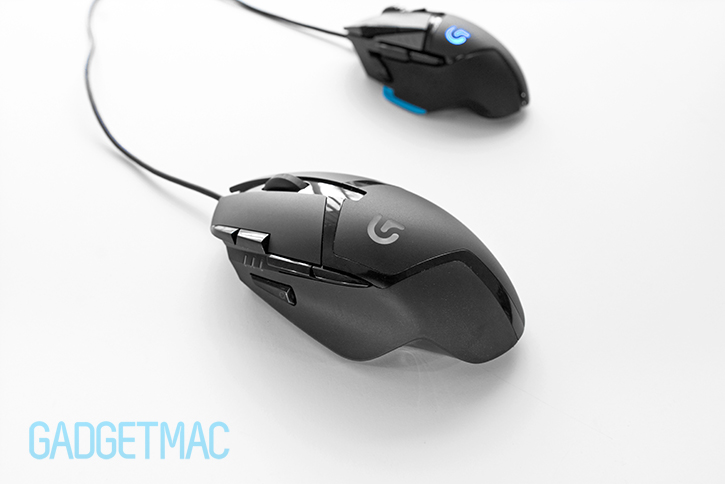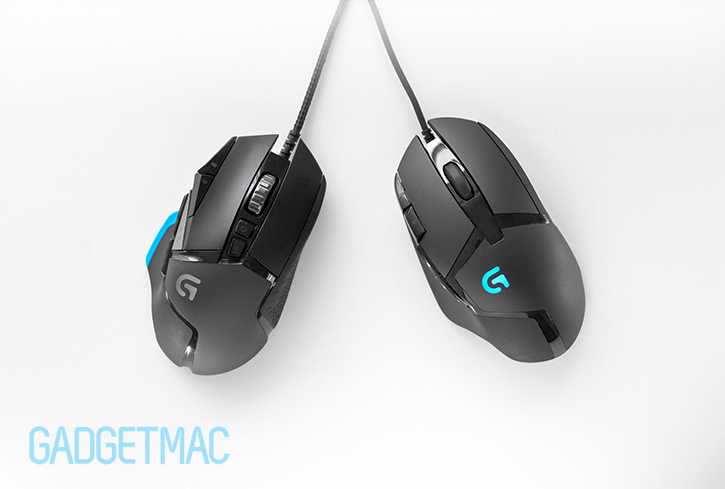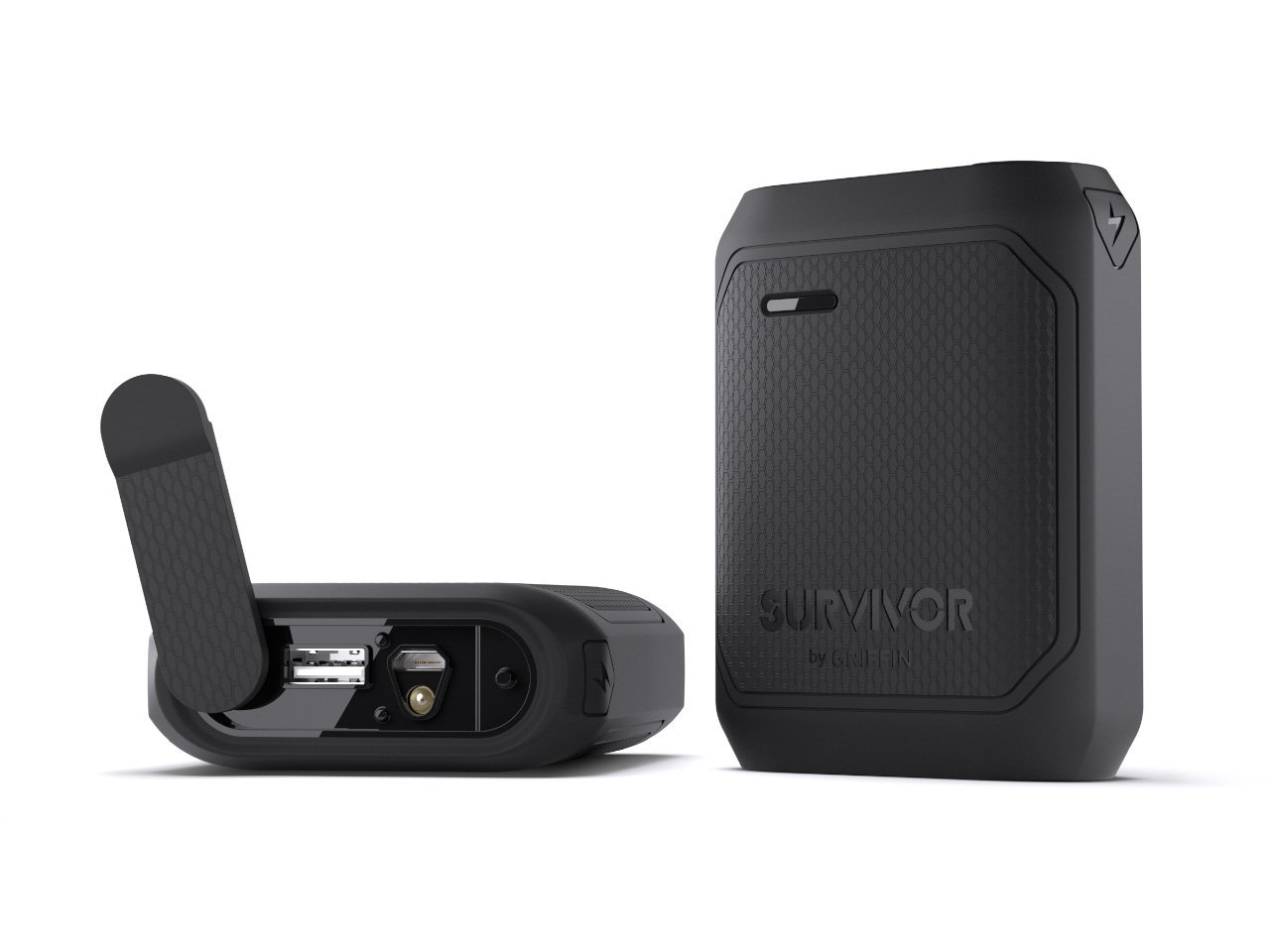Logitech G502 Proteus Core vs. G402 Hyperion Fury Review
/Logitech has recently come out with two new hyperbolical wired gaming mice promising speed, accuracy, agility and potentially unimaginable gaming performance prowess. The astonishingly futurist looking G502 Proteus Core (left) is Logitech's first weight-adjustable performance mouse featuring the company's advanced Delta Zero gaming-grade optical sensor capable of reaching super-human DPI levels of up to 12,000 without dreadful cursor acceleration, as well as an improved hyper-fast scroll wheel. And for those on a stricter budget, there's the new G402 Hyperion Fury gaming mouse. And although it does come with less premium features and a cheaper price tag compared to the G502, as its name suggest, the G402 is supposedly the world's fastest lab-developed mouse geared towards professional FPS gaming thanks to its gyro and accelerometer-enhanced Fusion Engine hybrid Delta Zero sensor technology, which is capable of tracking insanely fast hand movements of up to 500 ips without skipping a single beat. So which one should you pick? Stay tuned to our comprehensive comparison review after the break!
Before we compare the two, we're going to begin the review starting with the G502 Proteus Core. Easily Logitech's most impressively designed gaming mouse. Attractively garish is what it really is. Then again so are most gaming mice, and we don't really mind it. As long as Logitech keeps it below the insane over-engineering of the Mad Catz R.A.T series of gaming mice, we welcome all eye-candy. And although it's really nothing like the G500s, the G502 Proteus Core is its more refined successor.
Logitech's G502 Proteus Core will cost you as much as the wireless G602 gaming mouse at $80, and we think that's reasonable considering what you're getting in return. Conversely, the G402 Hyperion Fury will only set you back $60 at the cost of fewer features, simpler design and a blacked-out color scheme. Both mice are dextro, meaning they were designed for right-handed use only.
When compared to one of our favorite wireless gaming mice recently introduced by Logitech, the G602, you'll notice that that there are quite a few significant design and even material changes. But the general button placement, flared thumb rest body shape and accommodating index and ring finger buttons is still shared between the two.
the larger and slightly more ergonomic shape of the G602 forces your to use full palm contact grip which is very comfortable, whereas the G502’s narrower form factor has less of a curvier shape which enables it to be used with different grip techniques. And while the G502 does have a similarly sized thumb rest, I would have liked to see it have some sort of a pinky rest as well. Because unlike the G602’s slightly bulgy pinky rest area, the G502 hasn’t got any of that to offer and instead has a flat drop forcing you to exercise your tired pinky finger. Luckily however, that area is very well textured and does offer some additional grip so that it’s not all too bad.
Unlike the G500s which the G502 Proteus Core is replacing, Logitech chose an entirely different set of material composition to make the the G502. No, it's not made from metal or carbon fiber. It's still an all-plastic construction, and quite a high quality and sturdy build at that. The matte plastic used for the left and right buttons as well as for parts of the palm rest area features a fine granular texture that really isn't there to offer any grip, but it's also not a material that will cause you to sweat profusely. Also, it will not show any fingerprints despite having a matte finish - which is not a soft-touch type of coating mind you.
Although we'd prefer the same type of plastic to be used for the side function buttons, Logitech kept things classy with glossy black plastic for these. Replacing the G500s' more abrasion resistant sandpaper-like (or as we like to call it the DSLR camera body texture) material is smooth rubber making the G502 feel not as grippy as Logitech's G500s (discontinued) and G700s gaming mice at first, however, the new material composition used here still effectively works in providing the same level of grip even though it's more subtle without the feeling of touching coarse plastic that might have been dragged across pavement. As much as I like my G700s, I really do appreciate the smoother touch of the G502 Proteus Core and prefer it over Logitech's now older generation of gaming mouse. In between the matte and rubber plastics are some detail-enhancing incurved glossy plastic highlights that give the G502 Protues Core its complex looking futuristic design that you will either love or hate.
On the right side of the G502 Proteus Core is a finely textured rubbery grip area covered in a triangular pattern giving your pinky and ring fingers a place to hold onto without slipping off during intensive gaming. That same textured pattern keeps extending around the bottom of the mouse as part of the G502's attractive attention to detail and this whole futuristic-esque styling Logitech is going for with this mouse.
The same type of satisfying rubbery grip also covers the left side of the mouse where your thumb rests on a spacious extended thumb rest. The same type of rubbery grip seamlessly wraps around towards the back to provide additional grip when you rest your palm against the mouse.
Attached to the G502 Proteus Core is a non-removable highly flexible, and generously-long braided USB 2.0 cable. It's like every braided cable Logitech uses for its gaming mice, seemingly durable and affords a lightning quick 1ms response time without the need for any batteries of course.
As far as button placement and ergonomics are concerned, the G502 is really close to being perfectly balanced. That is if you're a right handed mouse user. All in all the G502 Proteus Core features 11 thoughtfully positioned and customizable buttons - left and right click buttons are included in that number. The majority of them being on the left side of the mouse, where you'll find them easily reachable using your thumb and index finger. To the left of your index finger you'll find the default mapped DPI up and down switch buttons, followed by a Logitech's familiar blue LED profile and DPI switching level indicator, with forward and backward web browser buttons beneath the LEDs followed by a single DPI shift button which when held will temporarily kick in a lower assigned DPI sensitivity for when you'd like an accurate sniping sensitivity.
There is a default profile switch button at the top of the G502 that sits right below the non-customizable scroll wheel mode switch, which is a similar button configuration found on Logitech's flagship wireless gaming mouse - the G700s. The scroll wheel itself is also a button that can tilt left and right affording a configurable 3-in-1 button. Speaking of buttons, the G502's left and right buttons use micro mechanical switches that offer terrifically satisfying tactile clicky feedback when pressed. They're a little loud, but have a snappy and shallow throw that feels very responsive. The same can be said about the rest of the G502's function buttons, however, they're not as tightly springy. Did we mention that you can literally reassign every single button on the G502 except for the mechanical button switch reserved for controlling the functionality of the dual-mode hyper scroll wheel.
The G502 Proteus Core is the second gaming mouse from Logitech to feature a famous dual-mode hyper-fast scroll wheel. And unlike its more expensive G700s associate, the G502 has its very own all-metal hyper scroll wheel, which explains the heavy duty knurling on it since it does not have any of the usual rubber to provide you with grip like all of Logitech’s classic dual-mode hyper scroll wheels do. This has also got to be the most robust and solid scroll wheel Logitech has ever put into its gaming mice. But since it is a hyper scroll wheel, it does effortlessly and smoothly roll back and forth when set to hyper-fast scrolling mode. And due to its weight, there’s a strong and satisfying inertia scrolling free-spinning effect when flinging the wheel up or down.
The only caveat to this particular design is that when set to click-by-lick mode using the dedicated button switch right below the wheel for more precise menu option or web page scrolling, the wheel ratcheting feature is a little too harsh requiring more effort to scroll using your finger in comparison to the G700s’ click-by-click hyper-scroll wheel mode. But is does work great when flipping between in-game weapons using notch-by-notch scrolling movements. Other than the dual-mode feature, you can also expect to use the G502's scroll wheel as a middle click button (which sadly does take some extra force to depress) including sideways page scrolling. Of course everything can be reassigned to your specific requirement. We don't really like the somewhat slippery metal hyper scroll wheel Logitech designed for the G502 and would have loved to see some type of grip infused into it.
The bottom feet on both the G502 and G402 are nothing new, they're exactly the same ones Logitech keeps using for all of its gaming mice and that's perfectly fine. They're highly slick and will let you slide your mouse across pretty much any surface including wood veneer with absolute smoothness and speed. When new, these feet glide across like a bar of soap on a wet floor. But like any PTFE low-friction feet, after a while these do wear out and lose some of their out-of-the-box slickness from eventually being scratched and scuffed by dirt. It looks like they can be easily replaced, which is good news no doubt.
Hidden behind a magnetic cover, which actually makes part of the thumb rest and is removed using the blue portion of the tab, is where you’ll gain access to the G502’s weight tuning core. Hence the name 'Proteus Core’. You’ll notice that the core offers multiple V-shaped segments in which you can insert the included weights. The blue layer inside the core is rubberized and is what keeps the weight in place using friction. You can divide the weights evenly or use them to balance the feel of the mouse to your liking by utilizing various position configurations afforded by the G502’s clever hexagonal patterned core.
There are a total of five weights included inside a slim storage case. With each weight weighing a mere 3.6g, there’s almost an insignificant change in the way that the G502 feels as it moves around. However, concentrating the weights towards the bottom does have a subtle affect on balance, which some may find to be beneficial. Also, by using all of the included weights amounting to 18g, users can play on higher DPI sensitivities whilst retaining a weighty cursor control.
Logitech's G502 Proteus Core is a fully featured, highly customizable mouse. The only thing you can't change is its shape. Not that you would really want to. That's where the Logitech Gaming Software comes into frame. It supports the latest versions of Windows as well as OS X, and with it you'll be able to customize each and every button on both the G502 and G402, create multiple profiles and set DPI sensitivity settings to your liking. DPI and polling rates dictate how sensitive, or how fast and precise your cursor movement will be. Thanks to Logitech recently updating its Gaming Software desktop app, the G502 is fully compatible with both Windows PCs and Macs along with the rest of Logitech's G Series mice and keyboards, except the Mac version currently lacks support for the G402 Hyperion Fury. Not to worry though as it usually takes a month or two until Logitech issues software support on Macs for newly released gaming mice. As for now, the G402 will still work on Mac, but you won't be able to adjust and save settings to it using the OS X Gaming Software app.
You'll also be able to control the lighting effect of the G502's blue-lit G logo. But won't be able to change colors sadly. The glowing blue Logitech G logo is a nice touch, but not necessary. Fortunately you can choose to either turn the backlight off or set it to turn off after a specified duration. Conversely, the blue G logo on the G402 Hyperion Fury model has a bit more customizable options using the same exact PC/Mac software such as choosing between a breathing or fixed backlight effect, adjust the brightness or set a sleep timer. Why aren't some of these features available when using the G502 is bewildering.
And should you find the need, you can also tune the G502's sensor accuracy using the Logitech Gaming Software, which will take you through a tuning process where you can maximize the accuracy on the type of surface that you're using with the mouse. Or you can choose from the presets already tuned to work best with the G502 such as Logitech's G240 gaming cloth mat and G440 hard gaming mat - both highly recommended if you are looking for a proper gaming surface. The G502's high-resolution Delta Zero optical sensor coupled with a 32-bit ARM processor is so good at accurately tracking your mouse mouse movements that you don’t even need to use a gaming or non-gaming mat. There’s absolutely no cursor skipping or jumping. As far as we know it, Logitech's Delta Zero sensor technology is faultless. It's one of the best sensors you can get inside a gaming or any mouse for that matter.
We should note that this specific software calibration feature is currently only available for the G502 Proteus Core and will not show up if you connect the G402 Hyperion Fury to your computer. Regardless of whether you'll find the need to fine tune your sensor to perform natively with whatever surface you're using it with, there's no denying the fact that Logitech have really stepped it up with the amount of user configuration options in its recent gaming mice offerings, and we really do appreciate that. Even without fine tuning the G502, it still performs superbly straight out of the box.
In the month that I have been using the G502 Proteus Core as my daily multi-purpose mouse I've found it to perform and track beautifully on every type of surface that I had put it on, be that on a regular old SteelSeries QcK fabric gaming mat or on a wood veneer Ikea desk.
The biggest difference Logitech is trying to market between the G402 Hyperion Fury and the G502 Proteus Core is that the G402 has the ability to track ultra-fast mouse movements up to 500 inches-per-second (IPS). But as true as it may be on paper, there's no realistic scenario where you would actually be benefiting from this hybrid sensor technology. I don't know anyone that moves so quick across a gaming mat to the point where the sensor cannot accurately keep track. It's like owning the fastest car in the world while using it to drive in a city only to never being able to push it to its full potential. That said, if you are that type of person burning up your mouse pad with an ultra-fast 360 quick-scope move, then you might find that having the world's faster gaming mouse under your control will put you at a slight advantage over your opponents. But who are we kidding.
Aside from insanely fast tracking capability, the G402 lacks the G502's sharper and snappier button feedback when using the left and right buttons. To be fair, it isn't something you'll immediately notice unless you directly compare the two models side by side. The G402 still performs fantastically well when it comes to offering tactile button press/click feedback.
The G402 Hyperion Fury has a non-braided, albeit seemingly durable USB 2.0 cable. It's definitely not as flexible as the G502's braided cable and it's significantly more in your way, which is something that might make a wired mouse user go wireless out of pure annoyance. Maybe paying more isn't always such a bad thing. Personally, one of the reasons why I dislike using the G402 is because of its cable. I'm usually a wireless mouse user, but really don't mind the G502's awesomely implemented braided cable.
If you're wondering which of these two tracks more accurately in day-to-day and gaming usage, all we can say is that the G402 performs exactly like its more expensive G502 sibling. They have the same sensor technology, and while you can only go as high as 4,000 DPI with the G402, it still as fast as the G502 when set to realistic DPI sensitivity levels. The biggest difference between the two is in ergonomics and in features. The G402 lacks some of the more premium features that you would have to pay $20 more for when going for the G502 like a weight adjustable core, braided USB cable, a dual-mode hyper scroll wheel, including the fact that it has fewer buttons (8 in total vs 11 on the G502), no surface calibration support and lastly, the G402 lacks the G502's impressively thoughtful styling.
Although they both share a very similar design language and are built using the same materials with the same matte finish and textures, the G402 has a slightly lower streamlined profile than the G502 and it isn’t as faceted in terms of design. It feels like a more simplistic mouse in the hand without arguably seeming cheaply made or engineered. In terms of comfort, both will not disappoint you, but I do feel like the G502’s toned shape offers a more comfortable grip using both claw and full-palm usage.
The G402 tends to fill up the very back palm area whereas the G502 features a higher mid-level hump that creates less palm contact. Don’t get me wrong, the G402 is still a very comfortable mouse to use as it’s a much lighter on its feet and effortless to move around. And if you prefer to use full contact with your mouse, the G402 offers a better shape compared to the G502 that promotes full-hand gip technique. The G402 feels a lot like using Razer’s Taipan despite its ambidextrous design as they both have a rather long low-profile shape with grippy side panels, only that the G402 features a more advanced button layout and is a better mouse overall.
The G402 has 8 configurable buttons as oppose to 11 on the G502, which means it also loses the tilting scroll wheel for a less fancy all-rubber wheel which does not feature a free-spinning mode. And while it's the same type of scroll wheel that that is found on the G602, it actually doesn't function nearly as smoothly. It has a tougher and noisier click-by-click scrolling action that's not as smooth to use, unfortunately. How does Logitech manage to mess up such a pleasing and simple scroll wheel?
What isn't so different between the two models is the fact that the G402 Hyperion Fury still features the same five button layout on its left side, which are all set to the same exact default button functions from DPI switching to back and forward web page browsing and are easily accessible by your thumb and index finger. There's even the same blue DPI and profile level LED gauge on the side. What the G402 doesn't have though is that extended thumb rest and pattern textured side gripping. The G402 does have a mild thumb rest, but it isn't as pronounced as the one featured on the G502.
They pretty much offer the same amount of grip, except for the fact that the G502 Proteus Core has some fancy textured patterns on its rubberized grip areas. But so does the G402's right side gripping, which features a ridges, albeit not as effective as the G502's highly textured side gripping.
With every mouse release, Logitech somehow manages to find different ways of improving and enhancing their already awesome offerings. Whether it's a new interesting design or a different material, Logitech is always trying to be one step ahead of everyone else. And this time it meant creating the G402 Hyperion Fury, the world's fastest FPS gaming mouse just because it can. We don't see its hyper-fast sensor tracking engine to ever kick in during normal gaming usage more than it being a bragging right spec. The company's recent release of the G502 Proteus Core shows us that you can still come up with exciting new designs and wild ergonomic mouse shapes all while introducing redesigned features like a weight and balance tuning system, new calibration software features and a newly designed all-metal hyper scroll wheel made to be more resilient under taxing gaming usage.
As much as we like the look of the G502 Proteus Core's all-metal dual-mode hyper scroll wheel, it's simply inferior to what we have come to expect from Logitech. It has a slippery metal finish despite its intense-looking knurled gripping along with a heavy ratcheting mode compared to the classic rubber-lined hyper scroll wheels, which we think are more refined in their click-by-click mechanics. The the micro-mechanical switches of the left and right buttons are extra noisy on the G502, albeit highly responsive as a result. Other than those two quirks, we really do think that Logitech has has a winning gaming mouse on its hands with the G502 Proteus Core. The only thing that would have made it even more enticing to a lot of users would have been a Proteus Core model with wireless capability. Though to be completely honest, I don't mind the fixed braided USB cable as much as I thought I would as I thoroughly enjoy using this mouse so very much.
With all that being said, we think that Logitech's fairly priced $60 G402 Hyperion Fury is not as impressive to use as the superimposed $80 G502 Proteus Core, and that was to be expected. However, we think that for someone that isn't looking to spend more than the asking price, the G402 will be more than enough if you want the best wired gaming mouse that has insanely good specs, a similar solid build quality to the G502, great software support for button customization, a relatively comfortable and good looking lightweight design with excellent tracking performance at a reasonable price. And because the G402 shares the same optical sensor found inside the more expensive and seemingly flagship-quality G502, it’s going to track every bit as good. The only drawback we found with the G402 Hyperion Fury is its mediocre scroll wheel mechanism. We really don't mind the fact that it has a regular non-braided USB cord considering it costs $20 less, but if you want the best, there's no denying that the G502's braided and more flexible cord is the way to go. Especially if you're coming from a wireless mouse.
In the end it all comes down to what feels best under your own hand. If you're looking for an inherently, yet weight-tunable, hefty mouse that will fit your hand amazingly well and will be comfortable to use for prolong periods of time in both claw and full palm grip use, then you may find that the G502 Proteus Core is one of the better gaming mice currently on the market. The G502 is an excellent multi-purpose gaming mouse when it comes to balancing two of the most common grip styles with its narrow and sleek body shape, while we have to give the G402 more credit when preferring a palming grip technique. Though neither are as comfortable to handle as Logitech's shapely G602 when it comes to using a fist full of hands-on grippage.
All things considered, the G502 Proteus Core is Logitech's finest wired gaming mouse the company has made in recent years. It's a fantastically customizable, well built and thoughtfully designed gaming mouse with excellent hardware, pin-point accuracy and of course supported by Logitech's excellent PC and Mac gaming software. And although Logitech hasn't got that metallic dual-mode hyper scroll wheel down as well as it should have, the rest is simply impressive. With just a minor drawback, the G502 Proteus Core offers a whole lot of mouse for $80. We love using it not only as a gaming mouse, but also as a brilliant versatile mouse. For that reason it wins our Editors' Choice Award.








